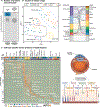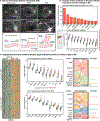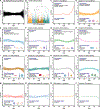Liquid-biopsy proteomics combined with AI identifies cellular drivers of eye aging and disease in vivo
- PMID: 37863056
- PMCID: PMC10720485
- DOI: 10.1016/j.cell.2023.09.012
Liquid-biopsy proteomics combined with AI identifies cellular drivers of eye aging and disease in vivo
Abstract
Single-cell analysis in living humans is essential for understanding disease mechanisms, but it is impractical in non-regenerative organs, such as the eye and brain, because tissue biopsies would cause serious damage. We resolve this problem by integrating proteomics of liquid biopsies with single-cell transcriptomics from all known ocular cell types to trace the cellular origin of 5,953 proteins detected in the aqueous humor. We identified hundreds of cell-specific protein markers, including for individual retinal cell types. Surprisingly, our results reveal that retinal degeneration occurs in Parkinson's disease, and the cells driving diabetic retinopathy switch with disease stage. Finally, we developed artificial intelligence (AI) models to assess individual cellular aging and found that many eye diseases not associated with chronological age undergo accelerated molecular aging of disease-specific cell types. Our approach, which can be applied to other organ systems, has the potential to transform molecular diagnostics and prognostics while uncovering new cellular disease and aging mechanisms.
Keywords: Parkinson’s disease; aging; artificial intelligence; diabetic retinopathy; liquid biopsy; longevity; proteomics; retinitis pigmentosa; single-cell analysis; uveitis.
Published by Elsevier Inc.
Conflict of interest statement
Declaration of interests V.B.M. has received speaker fees from Somalogic, Inc.
Figures







References
Publication types
MeSH terms
Grants and funding
LinkOut - more resources
Full Text Sources
Medical

